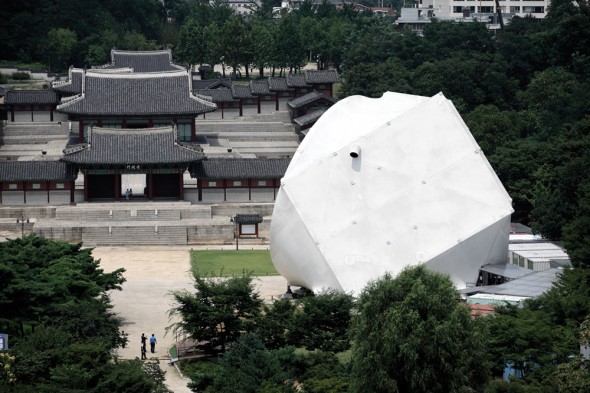
The tetrahedron-shaped Transformer celebrates movement, change and experimentation.
No one could accuse Miuccia Prada of having pedestrian taste in art, but even by her own standards, the mind-stretching art exhibition at the Prada Foundation space in Seoul will strike many as a brave choice. Under the ice-white roof of the Transformer, visitors will enter the felt-lined dreamscape installation “Turn Into Me,” conceived by one of Europe’s most provocative young artists, Swedish talent Nathalie Djurberg. They will then make their way into a shadowy cave and come face to face with the artist’s dark musings on the “natural” tendencies of violence and the basic instincts that unite us into one chain of being. Confrontational, disturbing and gruesome in its depiction of casual cruelty, with animated stabbing scenes and human and whale innards, the exhibition is certainly not for the faint-hearted.
This may seem to be a far cry from the elite world of smart boutiques where Prada plies her trade as one of the world’s most revered fashion designers, but this is precisely her intention. The non-profit Prada Foundation, founded with her husband, Patrizio Bertelli, was established in 1993 to bring to an international audience the “most profound thought provoking art projects of our times.” Curated by Italian critic Germano Celant, the Prada Transformer certainly achieves this, drawing thousands of visitors from around the world.
Located in downtown Seoul, and surrounded by skyscrapers on the grounds of the Gyeonghui Palace, the building is a mere ten-minute walk from the financial district. This dichotomy of the past struggling to maintain its hold against the impinging future makes the location a striking choice, with the Transformer serving as a bridge between the two.
The country itself is often described as being in a state of transformation, with South Korea poised to be one of the most future-forward economies in the world. Yet the country can at times also be resistant to change in terms of sacrificing cultural norms. However, this friction doesn’t seem to inhibit fashion and brand name goods. The project itself has also attracted sponsorship from local corporate giants LG Electronics and Hyundai. And the Korean desire for new fashion now seems to be trickling down into architecture as well, and is reflected in world-renowned Dutch architect Rem Koolhaas’s concept for the Transformer. Regarding the project, he says, “It has no average condition.”
Prada’s eclectic exhibition “Waist Down: Skirts” is also showcased in the structure and compliments the sweeping mechanics of the Prada pavilion and is an exhibition that celebrates movement, change and experimentation. It is fitting that her personal collection is being shown in a structure that can be reconfigured into a new shape. In an astonishing feat of 21st-century engineering, the space-age, tetrahedron-shaped Transformer, made from an elastic membrane stretched over a steel frame, can change into four distinct shapes: a hexagon, a cross, a rectangle and a circle. Everything from the building design, to the exhibitions, to the location, allow the Transformer to be worthy of bearing the names Prada and Koolhaas. The Transformer has plans to leave Seoul after the exhibitions, and the whereabouts of the next show are not yet known. After it is gone, it will be difficult to find a more fitting place for this structure; one that can mirror a city and culture in transformation so well.
– Megan McCluskie

